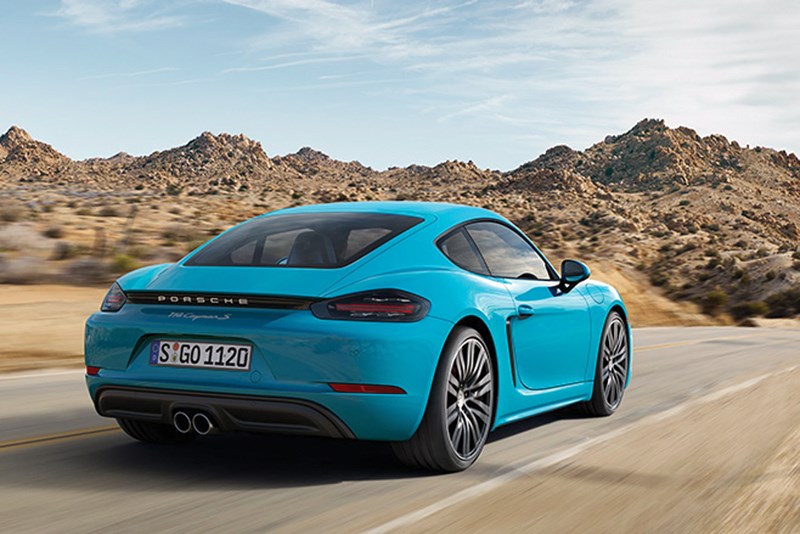Porsche’s third generation mid-engined sport coupe has arrived and it’s ready to shake up the purists. Say hello to the turbocharged flat-four Porsche 718 Cayman.
The 2017 Porsche Cayman comes in the base and S trims and they both retain the same platform as the last generation. For 2017, the chassis is re-tuned, the rear suspension reworked, and the brakes upgraded. The Cayman and the Boxster now share the same model designator: 718. The largest change between this model and the previous one is the replacement of the naturally aspirated 2.7 and 3.4-liter flat-six engines with turbo charged flat fours.
The decision to replace the flat six-cylinder engines with a turbocharged flat four has been the subject of scrutiny and vast debate. Does the redesign makes sense? In one word: yes.
Design
Porsche’s new Cayman now boasts a wider and more muscular stance, and sports a new Porsche badging on the rear. Paneling has been reworked along with headlight and taillight revisions. The result is an updated modern appearance that’s unmistakably Porsche from any angle.
Interior upgrades include a redesigned upper dashboard, a revised infotainment logic with more connectivity and device compatibility, and new steering wheels.
The Cayman is one of the best looking coupes around and it still gets plenty of “nods” from onlookers everywhere.
Performance
Beneath this glorious bodywork sits the new four-cylinder power-plant. The all new horizontally opposed 2.0-litre turbo engine produces 300 horsepower, while the S version uses a 2.5-litre that offers 350 horsepower. The 2.0-litre engine delivers up to 280 foot-pounds of torque, which is available between 1,950 r.p.m. and 4,500 r.p.m. This represents a 67 foot-pounds and 25 horsepower increase over the previous Cayman.
Superbness is the word that comes to mind when thinking of these engines. Porsche purists may not like the use of these new smaller turbocharged four-cylinder engines, but four cylinders have always been in Porsche’s history … the 356, 912, 937 and 968 come to mind.
Acceleration times have improved, with the 718 Cayman equipped with a PDK gearbox and Sport Chrono Package covering 0-100 kilometres per hour in just 4.7 seconds (0.7 seconds faster than the previous model). The Cayman S with similar equipment achieves this in just 4.2 seconds. The top speeds are now rated at 275 km/h and 285 km/h, respectively. And even more importantly, the fuel consumption has improved.
What else has improved? The 718 Cayman uses upgraded brakes with 330 millimetre brake rotors at the front and 299 mm at the rear as standard. The 718 Cayman S is equipped with the four-piston calipres of the 911 Carrera combined with thicker brake rotors.
The body roll improves as well, thanks to Porsche retuning the 718’s hydraulic vibration dampeners and combining them with higher stabilizer and spring rates. The rear wheels are now 0.5-inches wider and are shod with new generation tires which increase lateral grip, allowing for better cornering.
Environment
Inside the 718, revisions are instantly visible. The upper part of the dashboard and air vents are both new. The infotainment screen sits flush mounted in the dash console. Overall, the Cayman’s interior is very hard to fault. The controls are optimally placed for ease of operation and visibility is excellent even with the low driving position. The 334-litre storage capacity makes this a daily driver’s Porsche.
The steering wheel sports the 918 Spyder design, and connectivity options have been added to the Cayman cockpit. Porsche Communication Management and the eight-speaker Sound Package Plus audio system are standard. The entertainment package options include special extensions for smartphones (via the USB port), as well as Apple CarPlay and Porsche Car Connect. Drivers can also make use of additional comprehensive services via their smartphone, which includes the Porsche Connect App and Porsche Car Connect.
As in other Porsche sports cars, the Sport Chrono Package can now be adjusted using the Mode Switch on the steering wheel. Supplementing the previous settings of “Normal,” “Sport,” and “Sport Plus” is the “Individual” program, which can store and call up the driver’s preferred settings.
Features
The 2017 Porsche Cayman starts at $61,500 for the manual and $65,160 for the PDK. The Cayman S starts at $75,600.
As with any Porsche, the vehicle is compact, well- packaged with many options available.
Fuel efficiency numbers (litres/100 kilometres): 11.3 city; 8.3 highway for the manual; and 10.5 city and 8.0 highway for the PDK.
Thumbs up
The Porsche Cayman is attractive and great fun to drive. It moves and handles like a true Porsche.
Thumbs down
Not everyone likes the sound of the flat four, and the options add up quickly.
The bottom line
Porsche has shown that downsizing for economy reasons can be a plus for performance. The Cayman may be one of the best sports cars around.
Competitors
Chevrolet Corvette: The Corvette competes with the world’s greatest sports cars. With a 6.2-liter V-8 making 455 h.p. and 460 foot-pounds of torque, an eight-speed automatic is now available in addition to the seven-speed manual. The Corvette has shed its unrefined reputation, and offers world-class performance. Pricing for the Chevrolet Corvette starts at $64,695.
Alfa Romeo 4C: At an affordable level, the Alfa Romeo 4C is Italian’s sexy and exotic mid-engined car. It’s available as a coupe or a targa. Powered by a 237-h.p. turbo four cylinder, the Alfa Romeo 4C weighs less than 2,500 pounds. This power-to-weight ratio is the magic formula. The 4C has a tight interior, almost no luggage room and it’s low and tough to get in and out of, but who cares? It’s impressive when you are behind the wheel. The Alfa Romeo 4C is priced from $66,495.
Jaguar F-Type: Offered as both a coupe and a convertible, its amazing 3.0-liter supercharged V-6 pumps out 340 h.p. to the rear wheels through a six-speed manual or eight-speed automatic. The suspension tuning is firm, and the F-Type is always “ready,” but you’ll be in for a harsh ride over rough roads. The Jaguar F-Type’s pricing starts at $78,500.



